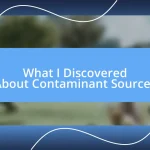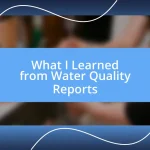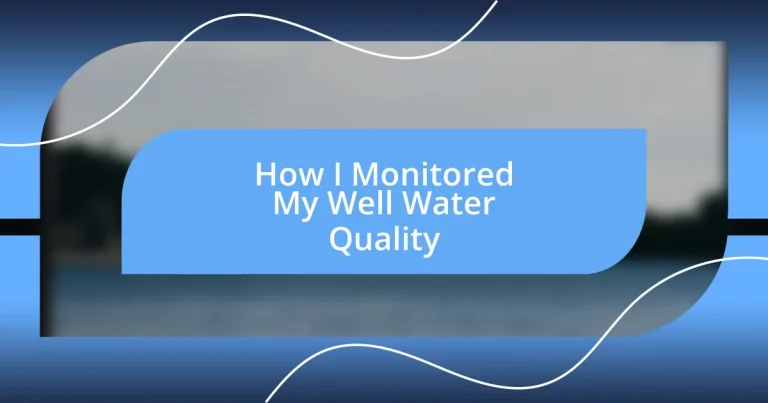Key takeaways:
- Regular testing of well water is essential for health and safety, with proactive monitoring enabling early detection of contaminants.
- Understanding key contaminants such as bacteria and nitrates, and their sources, is crucial for informed decision-making regarding water quality.
- Community engagement and consistent maintenance practices can enhance water safety and foster collective efforts in addressing contamination issues.
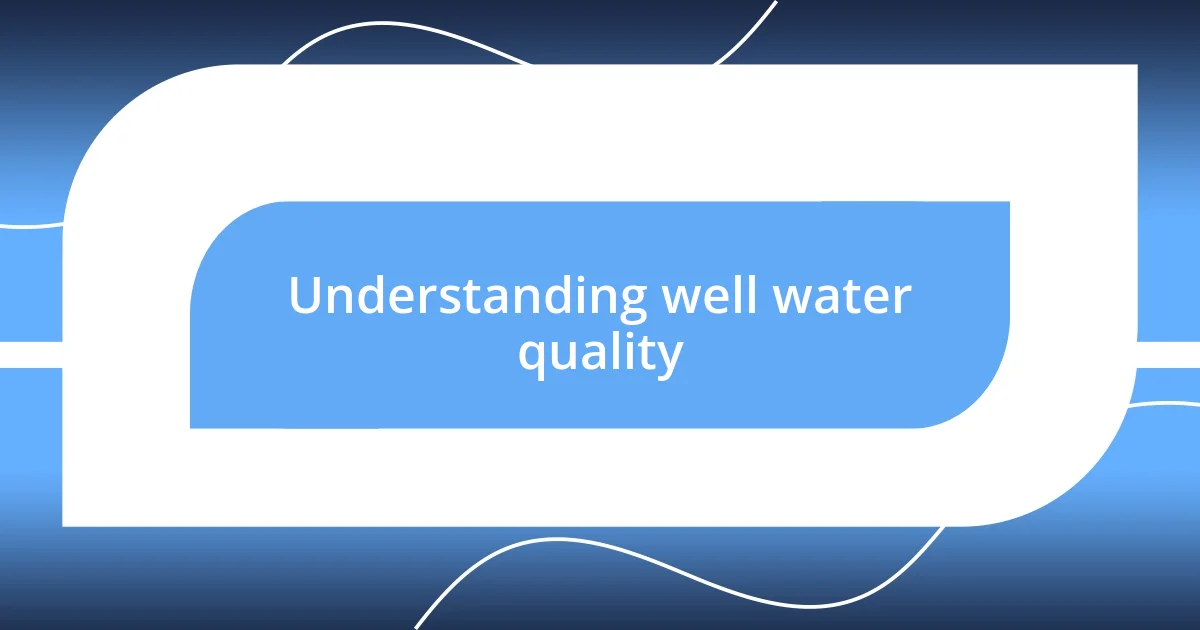
Understanding well water quality
Understanding well water quality is essential for both health and peace of mind. When I first moved to my rural home, it felt liberating to be connected to nature, yet I couldn’t shake the nagging worry about what was flowing from my tap. Have you ever wondered what unseen contaminants might be lurking in your well water? It’s a thought that kept me up at night.
I recall the moment I first tested my water; it was both exhilarating and nerve-wracking. The results revealed high levels of bacteria, and I was taken aback. This realization made me appreciate the importance of regular monitoring. It’s easy to overlook, but the quality of well water can shift due to changes in the environment or even seasonal variations. How often do you think about the sources of your drinking water?
Moreover, understanding the specifics of well water quality involves knowing the key indicators to watch for, such as pH levels, total dissolved solids, and potential contaminants. I remember grappling with these terms when I started. It took effort to educate myself, but the sense of empowerment that came with it was incredible. By recognizing these factors, you can ensure that your water is safe and healthy, providing a clear connection between your wellbeing and the environment around you.
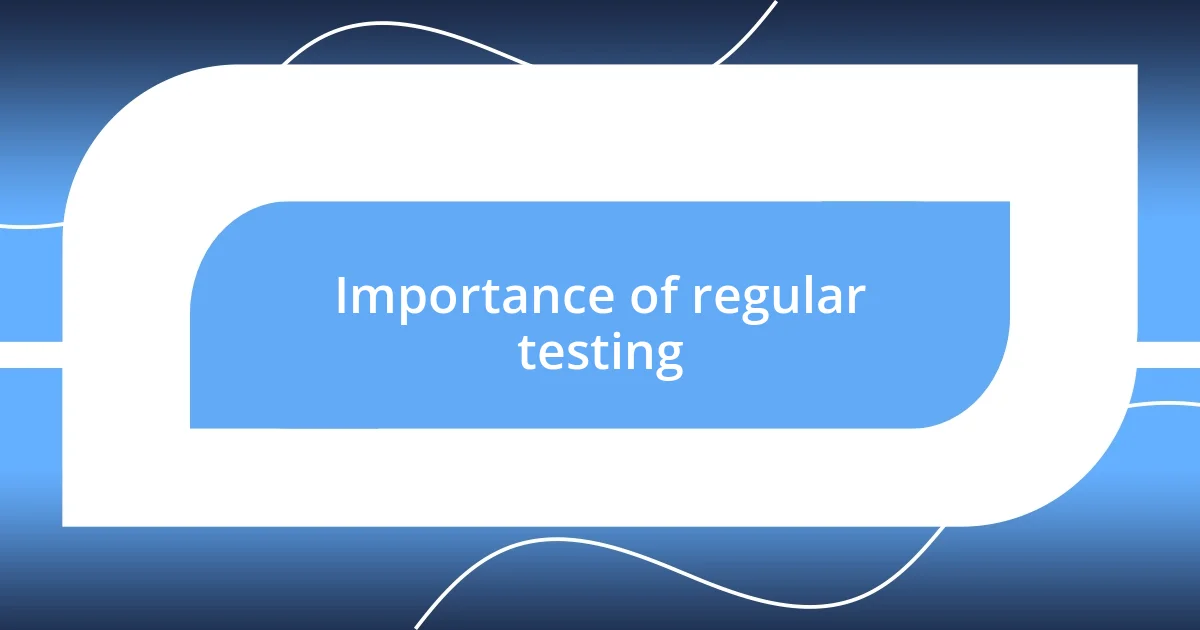
Importance of regular testing
Regular testing of well water is not just a precaution; it’s a crucial step toward safeguarding your health. I learned this the hard way when I neglected my well for a season and noticed a change in taste. A simple test revealed high nitrate levels that could have posed serious health risks, especially for children. It’s a stark reminder that water quality can easily fluctuate, and what you don’t test for can hurt you.
Here’s why I emphasize the importance of regular testing:
- Early Detection: Identifying contaminants before they reach unsafe levels can prevent health issues.
- Environmental Changes: Monitoring allows you to respond quickly to changes caused by rainfall, drought, or nearby agricultural practices.
- Peace of Mind: Knowing that your water is regularly tested provides reassurance for you and your family’s safety.
- Regulatory Compliance: Staying compliant with local regulations ensures your well is properly maintained and safe.
- Informed Decisions: Regular data helps in making informed choices about treatment options for your water.
Taking the time to test my well water consistently has transformed my perspective. Each result is like a window into the invisible world beneath my feet, revealing potential threats and allowing me to act decisively.
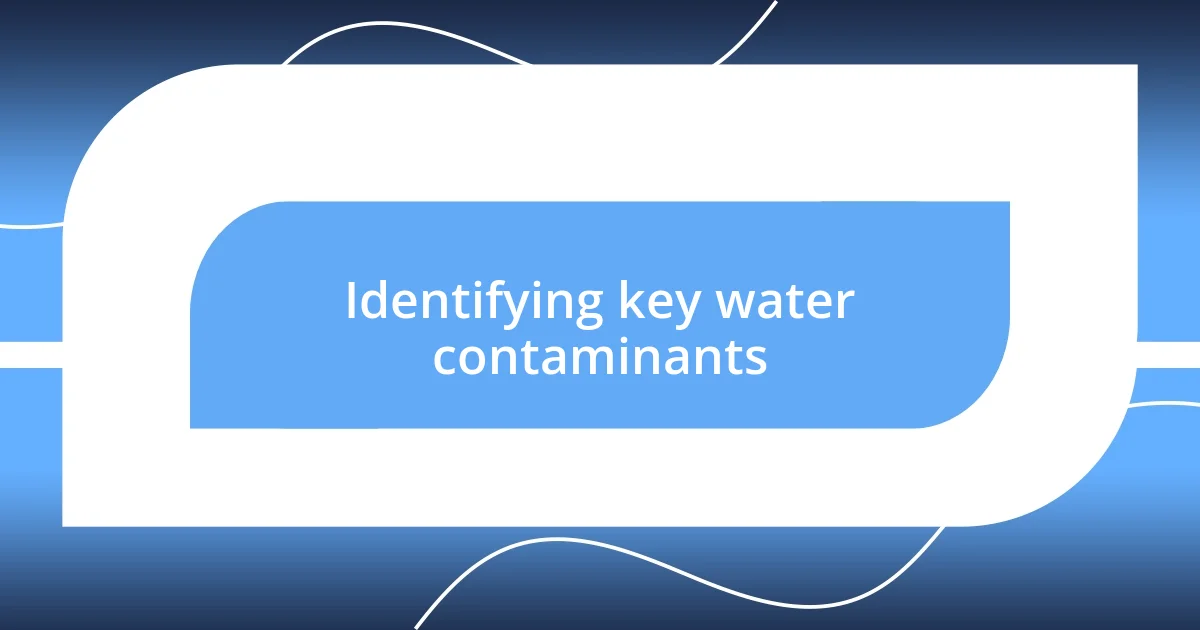
Identifying key water contaminants
Identifying key water contaminants is crucial for ensuring the safety of your drinking water. In my experience, I found it essential to familiarize myself with common contaminants like bacteria, nitrates, heavy metals, and pesticides. The first time I discovered lead in my water through testing, I felt a wave of panic wash over me. I quickly learned that monitoring for these contaminants is not just about knowledge; it’s about taking proactive steps to protect my family.
Among the challenges of well water quality, bacterial contaminants are often the most concerning. I remember vividly when I tested for coliform bacteria. The test came back positive, and it shocked me into action. Coliform is a type of bacteria found in the environment, and its presence often indicates that there might be harmful pathogens, too. Understanding these risks allowed me to prioritize follow-up tests and take measures to disinfect my water supply.
To simplify, I created a comparison table to help visualize various contaminants, their sources, and potential health effects, which really helped me keep track of what I needed to monitor.
| Contaminant | Source | Health Effects |
|---|---|---|
| Bacteria (e.g., coliform) | Animal waste, septic systems | Gastrointestinal illness |
| Nitrates | Fertilizers, sewage | Methemoglobinemia (blue baby syndrome) |
| Lead | Corroded plumbing | Neurological issues, developmental delays |
| Pesticides | Agricultural runoff | Cancer, reproductive problems |
By being aware of these key contaminants and their implications, I felt more equipped to maintain the integrity of my water supply—transforming my initial fear into informed action. Engaging with these details helped me build a stronger connection to the quality of water I consume daily.

Choosing the right testing methods
Choosing the right testing methods can be a game changer in monitoring well water quality. From my experience, the best approach is to use a combination of home testing kits and sending samples to a certified laboratory. I remember the first time I got a kit; it felt empowering to take charge of my water quality. But I quickly learned that while kits can give quick results, they often can’t detect everything. So, I regularly sent samples for professional analysis, which provided a fuller picture of what was lurking in my well.
When considering testing methods, think about what contaminants you’re most concerned about. For instance, if you’re in an agricultural area, you might want to prioritize nitric levels. I found myself focusing on heavy metals, especially after hearing about local concerns. I’ll never forget the unease I felt seeing arsenic on a list of potential issues. The knowledge that I could pinpoint such contaminants gave me peace of mind but also motivated me to act quickly.
Don’t overlook the importance of frequency in testing, either. Initially, I tested only a few times a year, but I soon realized that seasonal changes significantly impacted water quality. Have you considered how your water might change after heavy rains or a dry spell? Adjusting my testing schedule helped me catch issues before they escalated. Engaging with this process—not just keeping it at arm’s length—has profoundly shaped how I view my family’s health and well-being.
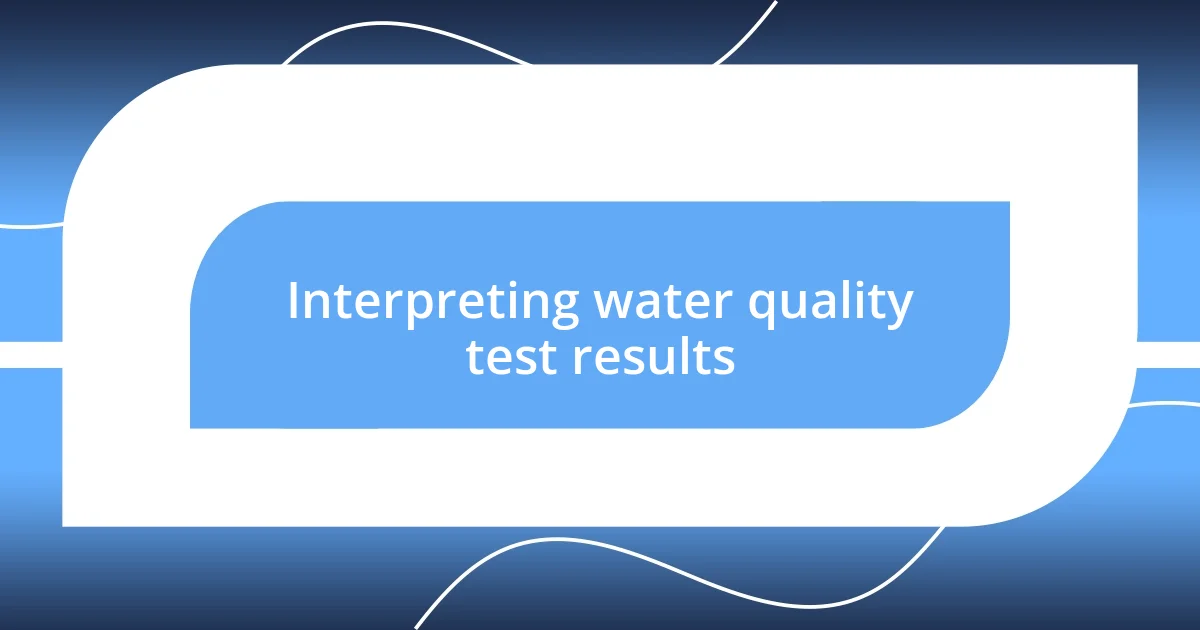
Interpreting water quality test results
Interpreting water quality test results can be daunting at first. I’ll never forget the mixture of confusion and relief when I received my first report. It listed contaminants like bacteria and nitrates, but I didn’t know what that meant for my family’s safety. I remember sitting down with a glass of water, feeling that familiar weight of responsibility, and diving deep into each contaminant’s implications.
When the results indicated high levels of nitrates, my heart raced. I recalled a recent conversation with a neighbor who mentioned how agricultural runoff could seep into wells. It dawned on me then: this wasn’t just data; it was a direct threat to my children’s health. Connecting those dots made me realize the importance of understanding context—what gets specified on a test is abstract until you relate it to your own environment. Have you ever felt that urgency when faced with alarming figures?
To make sense of my results, I crafted a simple system using colored markers. Green for safe levels, yellow for borderlining, and red for alarming ones. This visual representation helped me quickly gauge whether action was needed. In those moments of clarity, I felt a sense of control over a situation that initially felt overwhelming. Engaging directly with my water’s quality transformed how I viewed the results—not as numbers, but as a reflection of my family’s health.
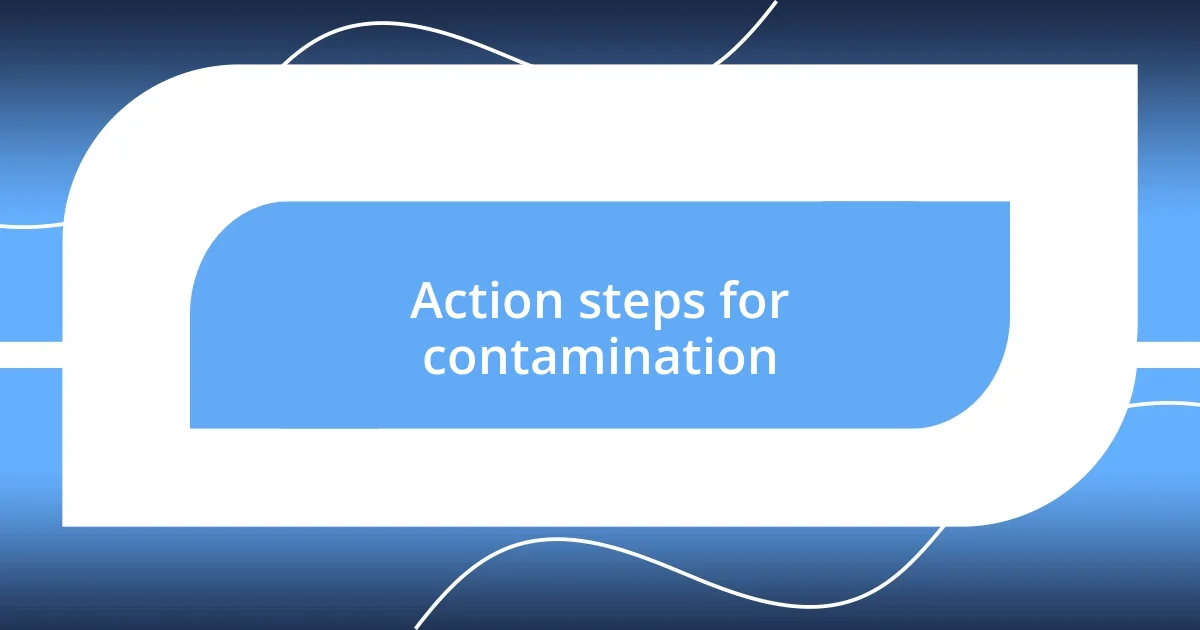
Action steps for contamination
When I discovered contamination in my well, the next steps were crucial. The initial shock pushed me into action mode. First, I reached out to a local environmental agency for guidance—they provided valuable expertise on how to approach the situation. They also suggested immediate measures, like installing a point-of-use filtration system. Ever felt that mix of anxiety and determination when your family’s health is on the line? I certainly did, and that drove me to make those changes quickly.
After addressing the immediate contamination, I recognized the importance of consistent upkeep. I made it a habit to regularly check and replace filters based on the manufacturer’s guidelines. I even set reminders on my phone! It may seem small, but that simple act gave me peace of mind. How often do we forget about maintenance until something goes wrong? Adopting a proactive mindset allowed me to take back control of my water quality, transforming what initially felt like chaos into a manageable routine.
Not all steps were technical; some were about community. I joined a local well owners’ association, where I learned from others’ experiences. Together, we discussed contamination incidents and effective strategies. Have you ever tapped into the power of community to tackle real issues? In sharing our stories, I felt less isolated, and it ignited a shared commitment to safeguarding our water. This collective action motivated me to keep monitoring and advocating for better water quality standards, proving that sometimes, the best solutions come from collaboration.

